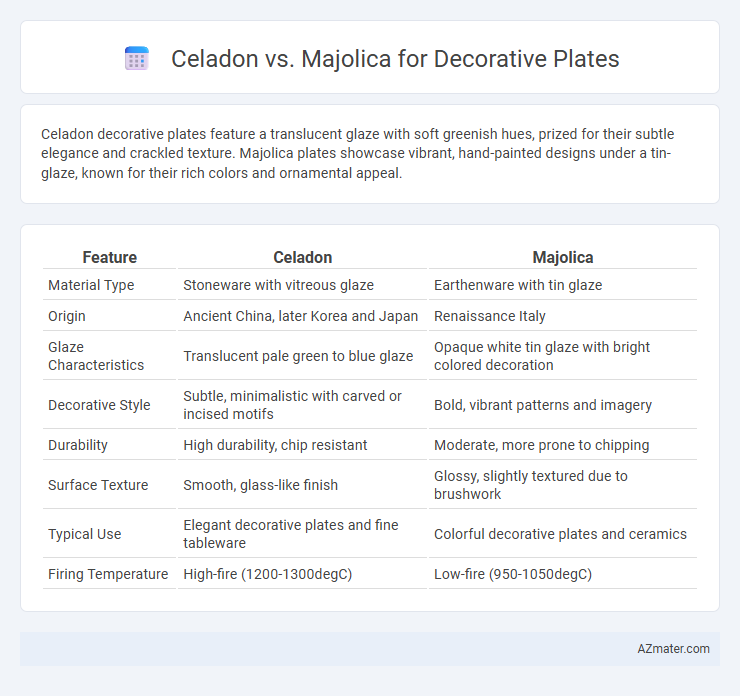Celadon decorative plates feature a translucent glaze with soft greenish hues, prized for their subtle elegance and crackled texture. Majolica plates showcase vibrant, hand-painted designs under a tin-glaze, known for their rich colors and ornamental appeal.
Table of Comparison
| Feature | Celadon | Majolica |
|---|---|---|
| Material Type | Stoneware with vitreous glaze | Earthenware with tin glaze |
| Origin | Ancient China, later Korea and Japan | Renaissance Italy |
| Glaze Characteristics | Translucent pale green to blue glaze | Opaque white tin glaze with bright colored decoration |
| Decorative Style | Subtle, minimalistic with carved or incised motifs | Bold, vibrant patterns and imagery |
| Durability | High durability, chip resistant | Moderate, more prone to chipping |
| Surface Texture | Smooth, glass-like finish | Glossy, slightly textured due to brushwork |
| Typical Use | Elegant decorative plates and fine tableware | Colorful decorative plates and ceramics |
| Firing Temperature | High-fire (1200-1300degC) | Low-fire (950-1050degC) |
Introduction to Celadon and Majolica
Celadon is a traditional ceramic glaze characterized by its translucent pale green or blue-green finish, originating from East Asia and prized for its smooth, jade-like appearance. Majolica refers to a type of tin-glazed pottery developed in the Renaissance, known for its vibrant, opaque, and colorful surface with intricate painted designs. Both styles serve as popular decorative plate options, offering contrasting aesthetics: Celadon's subtle elegance versus Majolica's bold and ornate patterns.
Historical Origins and Development
Celadon ceramics originated in ancient China during the Eastern Han Dynasty, characterized by their jade-like green glaze achieved through iron oxide in a reduction kiln atmosphere. Majolica, which emerged in the Italian Renaissance, is known for its tin-glazed, vibrant polychrome designs inspired by Islamic pottery techniques introduced via Spain. Both styles evolved through cross-cultural influences, with Celadon emphasizing subtle, translucent glazes and Majolica featuring bold, colorful narrative motifs on decorative plates.
Materials and Production Techniques
Celadon decorative plates are crafted from porcelain or stoneware and characterized by their translucent, jade-like glaze achieved through firing in a reduction kiln, which limits oxygen to develop calming green-blue hues. Majolica plates utilize earthenware clay coated with a tin-based, opaque white glaze, creating a bright, glossy surface ideal for vibrant, hand-painted designs, and are fired in an oxidizing atmosphere. The distinct firing environments and glaze compositions define the visual and textural differences between Celadon's subtle elegance and Majolica's bold, colorful appeal.
Visual Characteristics and Color Palette
Celadon decorative plates are renowned for their smooth, translucent glaze with subtle cracks and a muted palette dominated by pale green, soft blue, and gray tones, creating a serene and understated aesthetic. Majolica plates showcase vibrant, glossy finishes with rich, saturated colors such as bright blues, greens, yellows, and reds, often adorned with intricate, embossed designs and floral motifs. The contrast between celadon's minimalist elegance and majolica's bold, colorful artistry defines their distinct visual appeal in decorative ceramics.
Cultural Significance and Symbolism
Celadon pottery, originating from ancient China, symbolizes serenity and harmony with its jade-like glaze embodying purity and high status in East Asian cultures. Majolica, rooted in Italian Renaissance traditions, features vibrant, hand-painted designs that reflect life, fertility, and celebration, often showcasing mythological and natural motifs. Both decorative plates represent cultural heritage: celadon emphasizes subtle elegance and spiritual balance, while majolica highlights artistic expression and communal storytelling.
Durability and Functional Qualities
Celadon ceramic plates offer high durability due to their dense, vitrified glaze that resists scratches and chipping, making them ideal for regular use and display. Majolica plates, characterized by their porous earthenware base and vibrant tin-glaze, tend to be more fragile and prone to chipping, often serving better as decorative pieces than functional dinnerware. The durability of celadon enhances its functional qualities for daily dining, while majolica prioritizes aesthetic appeal despite lower resistance to wear.
Popular Decorative Motifs
Celadon decorative plates feature popular motifs such as lotus flowers, bamboo, and dragons, symbolizing purity, resilience, and power in East Asian art. Majolica plates commonly showcase vibrant floral patterns, peacocks, and mythological scenes, reflecting Mediterranean and Renaissance influences with bold colors and intricate designs. Both styles emphasize cultural symbolism, but celadon's subtle green glaze highlights natural themes, while majolica's bright enamels enhance narrative and ornamental motifs.
Collectibility and Market Value
Celadon decorative plates, prized for their jade-like glaze and subtle green hues, boast higher collectibility due to their historical significance in East Asian ceramics and limited production periods. Majolica plates, characterized by vibrant, tin-glazed earthenware with intricate hand-painted designs, attract collectors seeking artistic variety but generally command lower market value compared to celadon pieces. Market value for celadon often exceeds that of majolica, influenced by authenticity, age, and provenance in prestigious auction houses and private collections.
Modern Applications in Plate Design
Celadon and Majolica present distinct aesthetic qualities in modern decorative plate design, with celadon offering a smooth, translucent glaze that enhances minimalistic and contemporary styles, while Majolica features vibrant, hand-painted motifs ideal for bold, eclectic interiors. Designers increasingly leverage celadon's subtle green tones to create serene dining atmospheres, whereas Majolica plates serve as statement pieces, showcasing traditional artistry updated with modern patterns and color palettes. Both glazes adapt well to current trends, balancing heritage craftsmanship with innovative design elements for versatile decorative applications.
Choosing Between Celadon and Majolica
Choosing between Celadon and Majolica for decorative plates depends on your desired aesthetic and cultural preference. Celadon plates feature a smooth, translucent glaze with subtle green or blue tones rooted in East Asian pottery traditions, ideal for minimalist or traditional Asian-inspired decor. Majolica plates offer vibrant, hand-painted designs with rich colors and intricate patterns characteristic of Mediterranean art, perfect for adding a bold, rustic charm to your collection.

Infographic: Celadon vs Majolica for Decorative Plate
 azmater.com
azmater.com